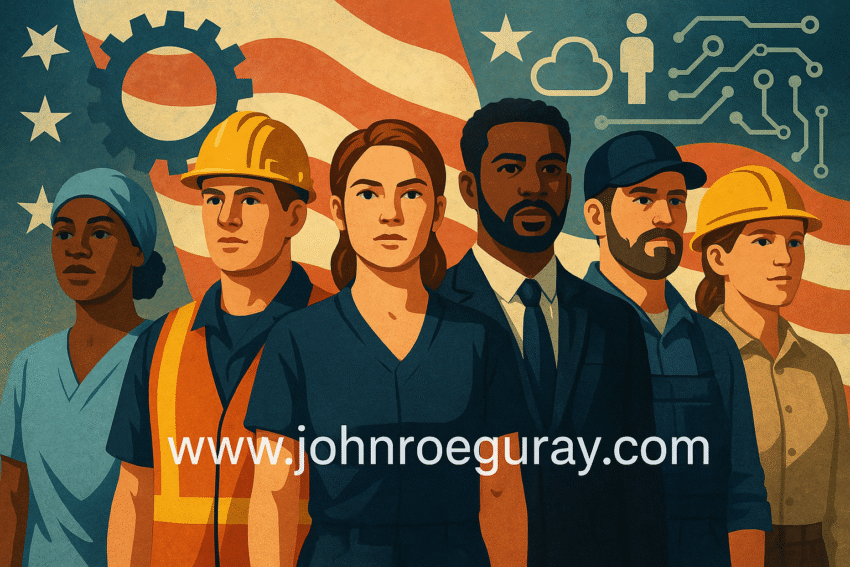As we observe Labor Day 2025 on Monday, September 1, we honor the contributions of working people across the United States — and confront pressing questions about the present and future of labor in a rapidly changing world.
Current Labor Landscape: Balancing Strength and Strain
Despite whispers of weakening, the U.S. labor market remains remarkably stable:
- Unemployment held steady at 4.1% in June 2025, barely budging from 4.2% in May (Federal Reserve Bank of St. Louis, Bureau of Labor Statistics).
- The July rate ticked slightly to 4.2%, joining a trend of modest cooling (Economic Policy Institute).
- However, job growth has slowed, with payroll additions averaging just 35,000 per month, a steep decline from 2024’s monthly average (MarketWatch).
- Simultaneously, worker productivity rose by 2.4% in Q2 2025, exceeding historical norms and offering a glimmer of improved living standards if harnessed wisely (Investopedia).
Still, macroeconomic and political pressures — like rate cut speculation, tariff uncertainties, and hiring pullbacks — threaten to constrain the labor sector’s upside (MarketWatch).
Economic Policy: Shaping Labor’s Trajectory
- At Jackson Hole, Federal Reserve Chair Powell signaled potential September interest rate cuts, aiming to bolster hiring and economic momentum (MarketWatch).
- Yet, hiring confidence is slipping: a Conference Board survey reveals that 20% of firms plan to slow hiring in the second half of 2025 — nearly double last year’s rate (The Wall Street Journal).
- Decision-makers juggle competing priorities: preserving employment while containing inflation, all amid growing political pressures (The Wall Street Journal, Investors).
Worker Wages and Living Standards
Wage growth remains moderate, and though productivity gains suggest the potential for real income improvements, broader challenges persist, such as regional unemployment disparities and federal layoffs — for example, across agencies like the EPA, USDA, and IRS — impacting public sector workers (Wikipedia).
The Untapped Power of the Labor Sector
Labor remains a potent force for social change:
- The “Fight for $15” movement continues building momentum, with 15+ states — including California — now pegging their minimum wages at $15/hour or higher (Wikipedia).
- The historical dignity and organizing power of labor can still fuel reforms — wage equality, collective bargaining, and community resilience — if revived with renewed purpose.
AI & Technology: Catalyst or Challenge?
Artificial intelligence is reshaping the labor landscape—and young workers are on the front lines:
- A Stanford study, corroborated by ADP data, found that employment among 22–25‑year‑olds in AI-impacted roles (software dev, customer service) has dropped ~16% since late 2022, even as wages remain stable (wired.com).
- Yet, AI may augment rather than replace: in sectors where AI acts as a tool — like diagnostics — young worker employment is rising (The Wall Street Journal).
- Looking ahead, the Bureau of Labor Statistics projects nearly 18% growth in software developer jobs and ~11% for database architects by 2033, hinting at new avenues for labor in tech-enhanced roles (Bureau of Labor Statistics).
- Research also highlights that AI-related roles increasingly offer rich non-monetary benefits — remote work, parental leave, wellness perks — alongside wage premiums, reflecting heightened demand and competition for skilled labor (arxiv.org).
- Further, AI tends to complement human skills more than substitute them: demand for digital literacy, teamwork, resilience — all align with the future of work (arxiv.org).
Labor’s Crossroads: Renewing Solidarity in an AI-Driven Era
Labor today stands at a crossroads. The traditional pillars — stable employment, rising wages, collective strength — are under pressure from slow hiring, political shifts, and AI-driven disruption. Yet, productivity gains, evolving roles, and emerging benefits signal a broader, more dynamic horizon. If mobilized with policy clarity and social solidarity, the labor sector can drive equitable prosperity in the age of automation.


